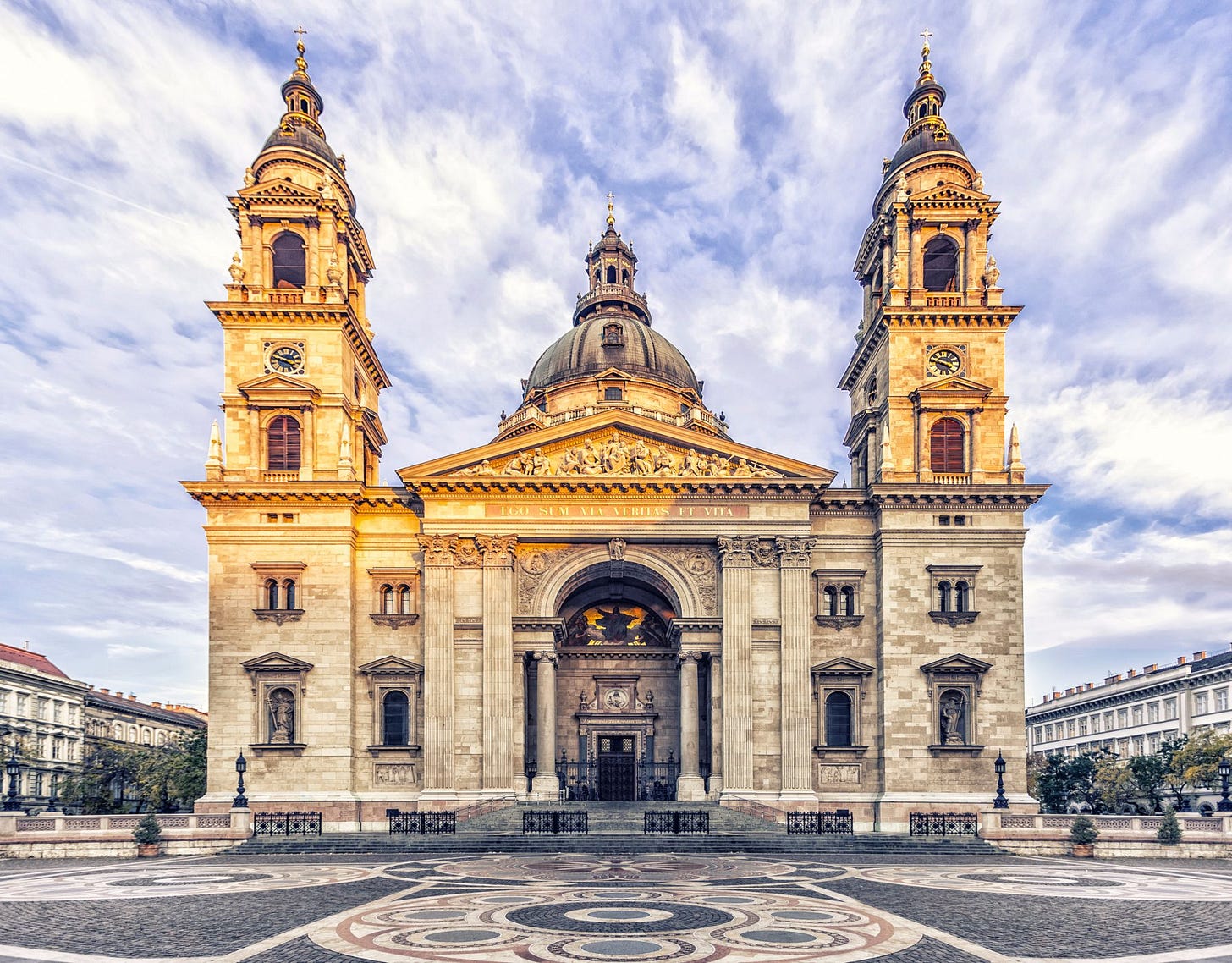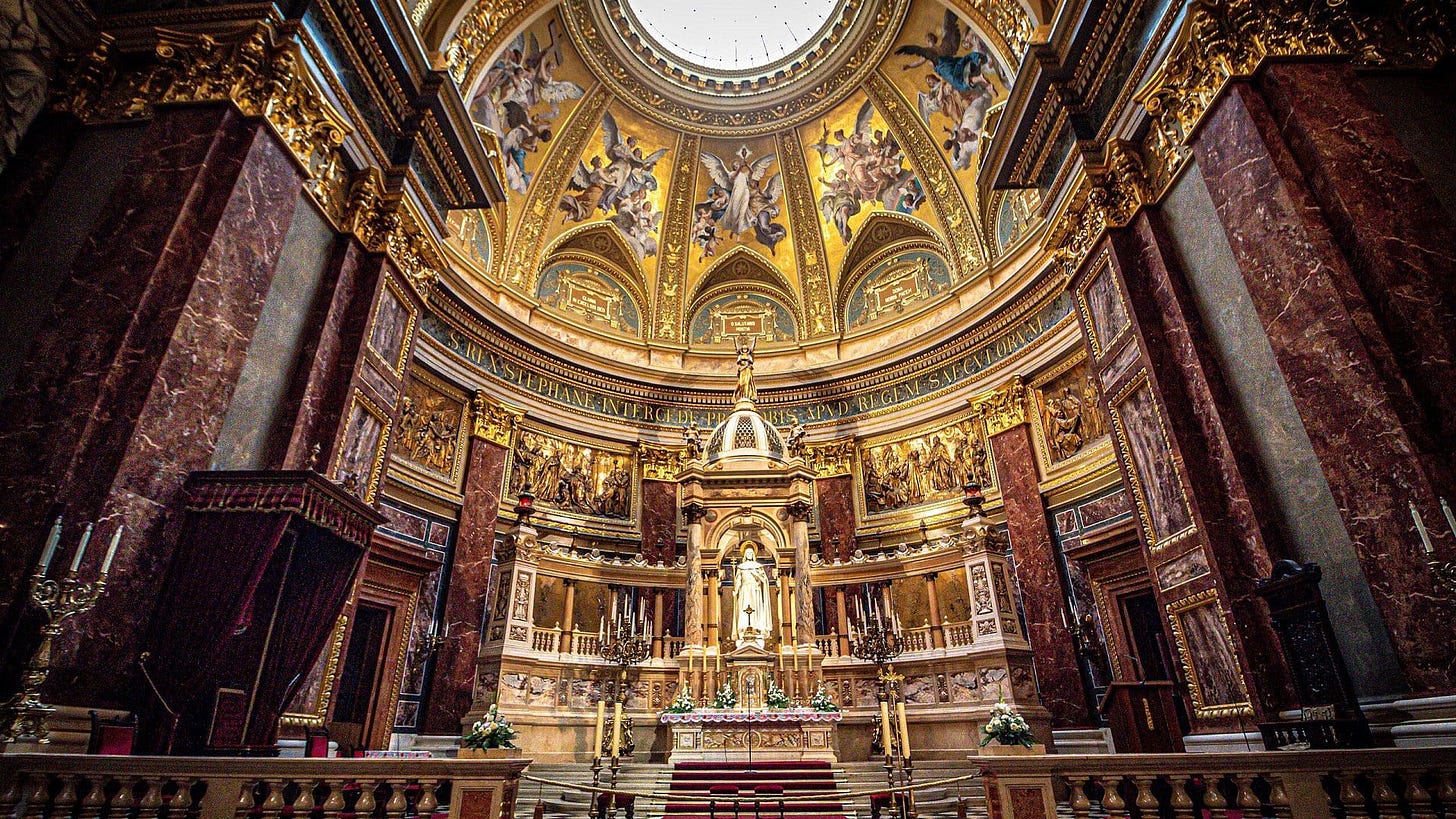From Saint István of Hungary to My Dad - a Personal History
"100 Days of Jókai Mór" February 1- April 30, 2025
Hungarian History Post 4 of 10
Love your comments on the stunning equestrian images of the Magyar chiefs I posted last night - and the enigmatic beauty of the weary young bride arriving with her nomad tent. I am absolutely mesmerized by her - captured with such empathy and perfection - the teenage foremother of a new nation on a new continent. The artist who depicted her so lovingly, Feszty Árpád (1856-1914), was named after Árpád - a name that is just as popular in Hungary as Attila.
The young bride’s cart is pulled by giant Hungarian Grey cattle - who still roam in the Hungarian puszta - the Pannonian Steppe along the Tisza River, on the banks of which I was born…
I last visited the Hortobágy National Park, the home of the Hungarian Grey cattle, with my dad in the fall of 2020 - it was a steely cold day which was briefly brightened by a spectacular November sunset which illuminated the crane-shaped draw wells of the puszta, the cattle lowing in the distance, as if the days of Árpád and his chiefs were still upon us...
My dad, a lung and heart surgeon by training and profession, was an indefatigable student of history. I inherited his passion for maps, dates, and facts - and historical connections to locations which he had explored all his life. A grandchild of a Hungarian grandmother, he travelled to Mongolia to discover the origins of all those tribes who conquered Hungary time and time again, from the Huns and the Magyars to the Mongols and the Turks - subjects of my future posts. He crossed the Volga River and found the mountain pass in the Carpathian Mountains which led Árpád into the Hungarian Plain. Dad introduced me to all the Hungarian historical sites I am posting in this tutorial - he spent years in libraries exploring original sources - and was always exited to share his knowledge of the past and its connection to the world of today!!! Thank you, dad!!!
King Saint Stephen of Hungary - Szent István király - was the first Christian king of the Hungarians. Born around 975, his feast day, August 20, is a public holiday, State Foundation Day. He was the last grand prince of Hungary and its first king from 1000 until his death in 1038. Stephen’s coronation regalia (including the crown) was sent to him from Rome by Pope Sylvester II. Saint Stephen was canonized by Pope Gregory VII in 1083.
At birth he was given the pagan name Vajk, and even though his parents were baptized, he became the family’s first practicing Christian. I was astonished by the painting depicting his baptism when I first saw it in my teens. The humble submission of this giant of a man was bewildering - his tangled hair braided with black pearls…
When his father Géza passed away, he went to war against the pagan lord Koppány who claimed the throne on the basis of seniority. Stephen - or István - won, thus establishing Hungary as a Christian nation where the throne is passed on through the laws of primogeniture. This is the event that Hungarians celebrate annually on August 20. Hungary’s entry into its European home was sealed with Stephen’s marriage to Gisela of Bavaria (c. 985 - 1065), sister of the Holy Roman Emperor Henry II.
Stephen outlived all his children and after his death Hungary descended into a civil war which destabilized the country, but did not destroy it thanks to the solid foundation established by Stephen. What the Huns and the Magyars could not accomplish, territorial stability, was István’s gift to posterity.
His shrine has been established in Budapest’s Saint Stephen's Basilica which houses his holy relicts. A stunningly gorgeous Neoclassical building constructed between 1851 and 1906, today it is a UNESCO World Heritage Site.
István inspired multiple musical compositions, including Ludwig van Beethoven’s "King Stephen Overture," composed in 1812 for the opening of the Hungarian Theatre in Pest.
Erkel Ferenc, the composer of the national anthem which I posted a couple of weeks ago, dedicated his final opera to Stephen - "István király" was completed in 1885.
And if you are curious to find out what I was listening to on my Walkman in my teens - it was the 1983 rock opera "István, a király" ("Stephen, the King") by the immensely talented Szörényi Levente and Bródy János - which literally rocked the world of Hungarian speakers both in Hungary - and outside its borders - providing a sense of cultural unity and cohesion which partly contributed to Hungary attaining its independence from the Soviet Union in 1989.
The legacy of a king that has lasted a millennium…
After all this history - we are taking a break tomorrow!!! Please listen to the musical compositions dedicated to saint Stephen of Hungary!!! On Thursday - yet another nomadic invasion from the East - the Mongols!!!
The Baptism of Vajk, 1875, by Benczúr Gyula (1844-1920), Hungarian National Gallery, Buda Castle, Budapest.
Saint Stephen's Basilica (Szent István-bazilika), 1851-1906, Budapest, UNESCO World Heritage Site.
King Saint Stephen of Hungary, Buda Castle, at the Fishermen Bastion, 1906, by Stróbl Alajos (1856-1926). I posted my photo of this statue in January - the views of the Danube from this location are SPECTACULAR!!!
The sculptor, Stróbl Alajos, also created Jókai Mór’s statue on Andrássy Avenue (situated a couple of blocks from the Hungarian National Opera), the Arany János monument (in front of the Hungarian National Museum in Budapest where the Revolution of 1848 began), and the Matthias Fountain in the Buda Castle (location of severe fighting during the Revolution of 1848). I will post the image of this fountain in my note dedicated to King Matthias!!!
The sculptor Stróbl Alajos is buried in the Kerepesi Cemetery in Budapest, along with the novelist Jókai Mór, the poet Arany János, the revolutionary Kossuth Lajos, the composer Erkel Ferenc, and my dad, Husznay Tamás… Yes, everything is connected!!!








